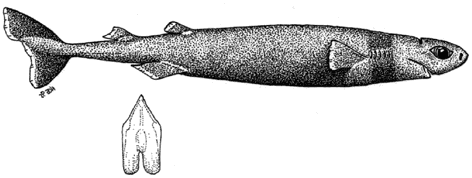Cookiecutter Shark(Isistius brasiliensis)

(Quoy & Gaimard, 1824)
| Fr: |
Squalelet feroce |
| Sp: |
Tollo cigarro |
| It: |
Squalo Cookiecutter (Messina) |
| Ma: |
N/A |
Diagnosis
A small, slender, cigar-shaped shark with two very small
spineless, roughly subequal dorsal fins set posteriorly and close
together; no anal fin; ventral lobe of caudal fin noticeably
well-developed and almost subequal to dorsal lobe. Low keels on
caudal peduncle. Snout short, bulbous and broadly conical; eyes
fairly large; spiracles prominent. Lips fleshy and expanded;
lower-jaw teeth conspicuously large, triangular-cusped, in 25 to 31
rows; upper teeth small. Gill-slits very small. Pectoral fins small.
Colour dark brown or dark tan dorsally, lighter ventrally; a
distinctive collar of darker pigment encircling the anterior body at
the level of the gills. Posterior margins of all fins lighter and
rather transluscent.
Size
To about 50cm. Size at birth unknown.
Status & Distribution
Mediterranean Sea: Very rare but essentially unknown
regionally. Apparently western and central Mediterranean, in the
Ionian Sea and southern Tyrrhenian Sea near Sicily (?)
Northeastern Atlantic: Southern areas of the region,
primarily from about the Cape Verdes southwards; usually far
offshore over deep oceanic waters.
Biology
A rather poorly-known, enigmatic shark of widespread but spotty
distribution in warmer oceanic waters, ranging from the surface down
to at least 1000m and probably undertaking diurnal vertical
migrations over considerable distances; normally encountered far
offshore over deep water. Cookiecutters are unique sharks, having
gained notoriety as facultative ectoparisites upon a wide variety of
large marine animals, including cetaceans, northern elephant seals,
and other pinnipeds, tunas, billfish and even the equally-mysterious
megamouth shark. Their predatory ethology is probably one revolving
around surprise ambush - luring potential and unwitting predators to
within range, perhaps by bioluminescent attraction and thereby
imitating squid or similar creatures. The cookiecutter then "turns
the tables", so-to-speak, by attacking (sometimes head-on) and
attaching itself ghoul-like to the skin of its prey. The
specialised, suctorial lips and fearsome lower-jaw teeth are clearly
effective in removing deep round plugs of tissue from prey (i.e.,
"cookiecutting"), as attested to by the fresh and healed wounds
inflicted by these sharks upon other animals. The writer has seen
one subadult female northern elephant seal hauled-out at S.E.
Farallon Island, Marin Co., California, with at least three fresh,
closely-spaced cookiecutter bites to the thorax although whether
these were inflcited by a single shark in quick repeated bouts is
unknown. Cookiecutters have damaged the sonar-dome covering on
nuclear submarines through opportunistic attacks. The Mediterranean
citation follows recent observations by Dr. Antonio Potoschi and
colleagues, engaged in studies of bluefin tuna and swordfish at the
Dept. Marine Biology, Univ. Messina, Sicily (pers. comm.), who have
noted "very fresh" cookiecutter bites to bluefin tuna caught off
Sicily. According to Potoschi, these bites can only have been
inflicted within the Mediterranean, and most likely near Sicily,
based upon the known migratory routes and spatiotemporal
distribution of varying size-classes of bluefin. If correct, then
the Mediterranean occurrences would seem to imply two further
prospects.
- The potential for these sharks to be caught elsewhere within
the Northeastern Atlantic, north of Cape Verde;
- The possibility that these sharks gather seasonally at
favourable "ambush sites" located upon the migratory routes of
bluefin tuna and similar large prey. It seems inconceivable that a
cookiecutter shark could actively shadow bluefin tuna over any
great distance, but arguably raises the further question as to
whether these sharks can "hitch" rides upon migratory prey in some
remora-like fashion over large distances.
The Shark Trust, 36 Kingfisher Court, Hambridge Road, Newbury, Berkshire, RG14 5SJ, UK.
Tel(+44) 01635 551150, Fax(+44) 01635
550230
|